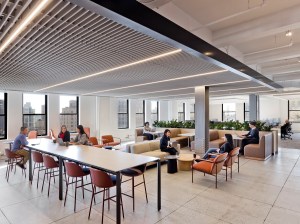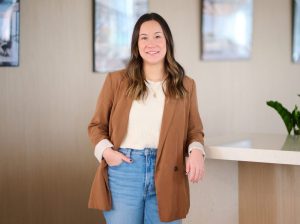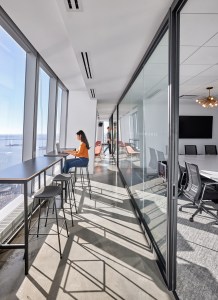Why Having a Workplace Strategy Is a Must Today
Spectorgroup's Lauren Gardner on how future-proof workplaces can contribute to organizations' long-term success.
After venturing into graphic design and advertising for a few years, Lauren Gardner returned to her true calling: architecture. Today, she is the director of Creative + Strategy at Spectorgroup, a New York-based architecture and design firm established in 1965.
Gardner’s multidisciplinary background has helped her create a unique vision and original approach to office design and workplace strategy, two concepts that grabbed headlines in the aftermath of the health crisis. With more than a decade of experience working in the architecture industry, interior design and master planning, Gardner weighs in on why workplace strategy is essential in today’s complicated office landscape, and talks about how it can support all the new, flexible ways of working, while boosting employees’ productivity.
READ ALSO: Shaking Up the Status Quo in the Design Industry
How did you get started in this field and what drives you to excel in today’s CRE landscape?
Gardner: I started my career in high-end residential in 2008 during the economic crisis, which I think had a significant impact on my non-linear career path. When I was ready for my next step, most large firms were going through massive layoffs, so I decided to expand my portfolio into graphic design and eventually started working at an advertising firm. Two very different experiences that also have a lot of synergies in their approach to research, design, strategy, concept development and storytelling. It also provided me with a completely different perspective on workflow, collaboration and work culture.
When I re-entered the architecture industry, I naturally gravitated toward workplace strategy. What drives me is the opportunity to work across all industries and learn from top organizations. It is exciting and it continues to push and evolve our processes.
How exactly does your multidisciplinary background help in executing projects?
Gardner: I think my background in marketing and strategy helps me approach projects from multiple perspectives to ensure that client goals are heard and realized throughout the design process. Strategy, branding and design all go together to create a more dynamic story and experience.
Many tenants and owners have now moved toward experiential and high-quality office buildings. Has this demand been reflected in your work? Where do you see the trend going?
Gardner: We are seeing more organizations who are looking at their office as a destination and brand hub, and who want to create a design journey that authentically reflects their brand story and mission to establish a stronger connection with their employees and clients. I think this connection is something that cannot be replaced virtually and was hindered during the pandemic.
I hope that this trend pushes organizations to look inward to determine what role the office should play in their future planning and not make decisions based on preference, but on data. This puts a greater demand on the workplace strategy process, which helps capture the unique elements and needs of a company and translates them into purposeful solutions to support new ways of working.
Wellness as a concept gained much traction in recent years. In your experience, how has it evolved and what are some of the main fundamentals of designing an office space around wellness?
Gardner: I think wellness is less of a concept now than it is an expectation. It has evolved from checking the box of having a wellness room to a more holistic approach focused on how employees will feel within the space and should be integrated into all aspects of the workplace. Access to daylight and views is always the top request or concern from employees and is a priority in how we plan our spaces.
Employees want to feel safe and supported when they come to work, so planning the right balance of space types allows them to work in the type of environment that best suits their individual needs, fostering inclusivity and choice. Creating warmth with natural materials and greenery, and selecting comfortable furniture, all help to create a healthy workplace experience.

Spectorgroup’s headquarters was built with wellness design principles in mind. Image courtesy of Spectorgroup
Is there a recent office project you’ve worked on that exemplifies some of these trends?
Gardner: Our new headquarters is a great example of an inclusive process that resulted in a space that reflects our culture and work ecosystem. Our hybrid work model and the design of our space support the fact that collaboration is at the heart of our practice. The plan is centered around a large hospitality lounge designed for employees, clients, and visitors to eat, meet, learn, and socialize. The overall vibe is welcoming, creative and comfortable, and has definitely had a huge impact on the energy and productivity of our team.
What is Spectorgroup looking forward to in 2023 in terms of office design? Any new tools and methods you are eager to expand on?
Gardner: We have had the opportunity to work on some exciting projects that are blending retail and customer experience with the workplace. With the retail space readily available and the increase in remote work within certain sectors, there is an opportunity to reimagine the role of the office and bring together trends in coworking and experiential design.
Workplace strategy is also about bringing diversity, equity and inclusion practices to the forefront. How can companies advance DEI within and beyond their office walls?
Gardner: Firms must be open to continuous learning, training and be willing to adapt. The younger generation is the most diverse group entering the workplace and are advocates of change and we need to create a platform where that is fostered. Through our strategy and design process, we also need to become better listeners to understand what will make a difference in people’s lives and experiences.








You must be logged in to post a comment.